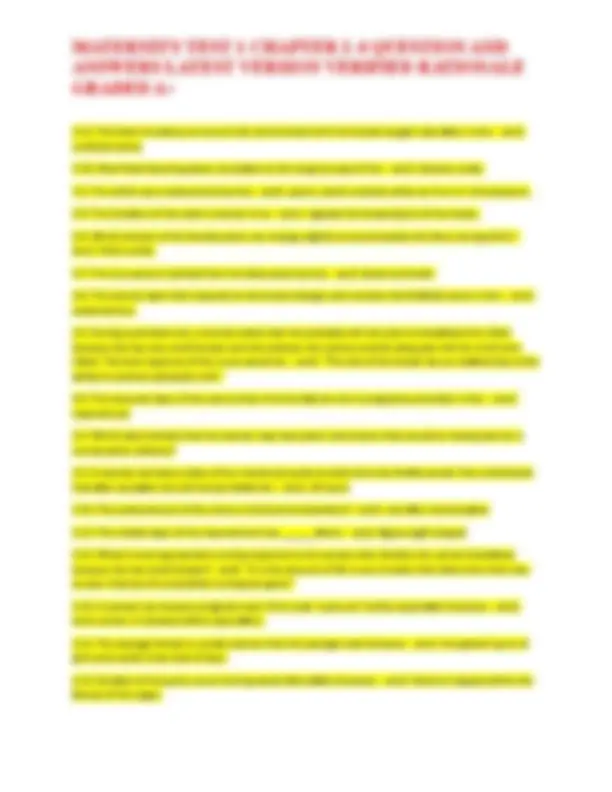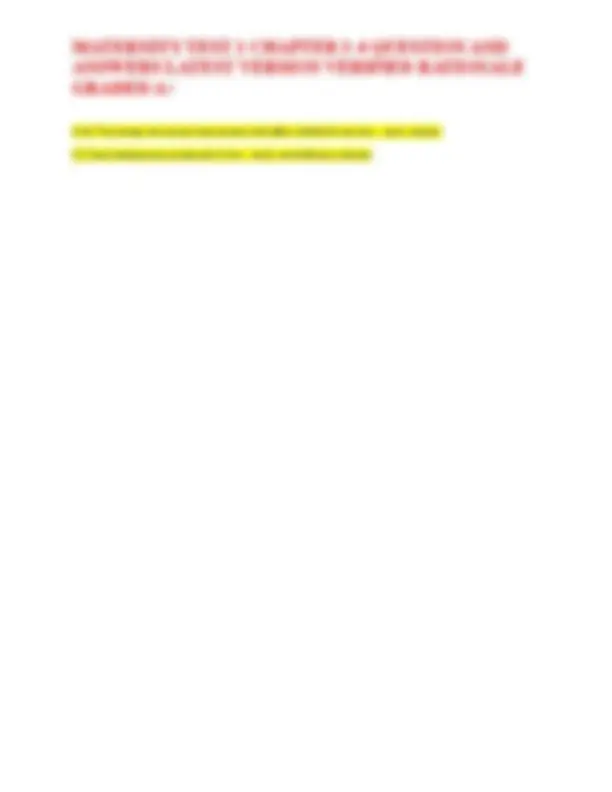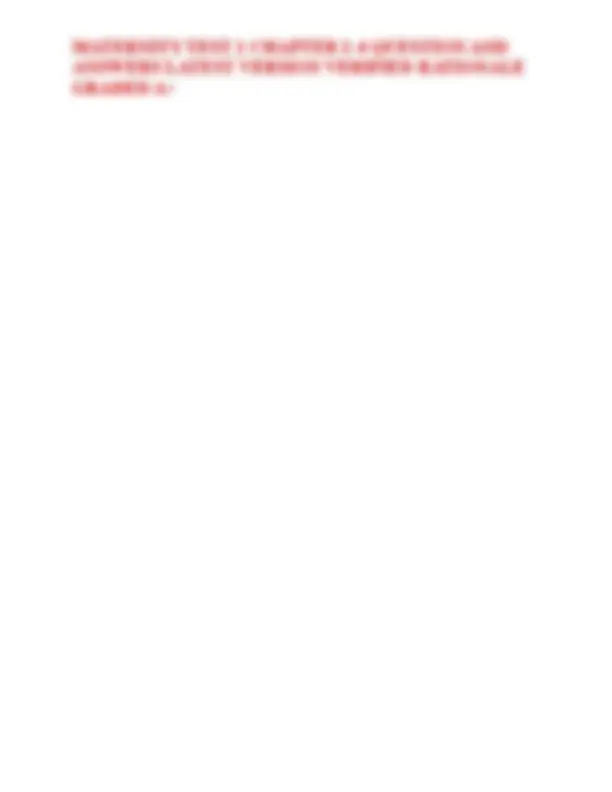





Study with the several resources on Docsity

Earn points by helping other students or get them with a premium plan


Prepare for your exams
Study with the several resources on Docsity

Earn points to download
Earn points by helping other students or get them with a premium plan
Community
Ask the community for help and clear up your study doubts
Discover the best universities in your country according to Docsity users
Free resources
Download our free guides on studying techniques, anxiety management strategies, and thesis advice from Docsity tutors
MATERNITY TEST 1 CHAPTER 2-4 QUESTION AND ANSWERS LATEST VERSION VERIFIED 2025 RATIONALE GRADED A+.pdf
Typology: Exams
1 / 6

This page cannot be seen from the preview
Don't miss anything!




A woman with a(n): - ans2. gynecoid-shaped pelvis with a history of rickets 4/3: During a prenatal examination at 30 weeks of gestation, a woman is lying on her back on the examining table.She suddenly complains of dizziness and feeling faint. The most appropriate response of the nurse would be to: - ans4. turn the woman onto her side. 4.9: While lying on the examining table during her prenatal check at 34 weeks, a woman complains of being dizzy and weak. She is pale and her skin is moist. The best nursing intervention to relieve her symptoms is to: - ans1. have her turn to her side. 4.8: A woman's emotional reaction during the 2nd trimester of pregnancy may be characterized by: - ans3. fantasies about the baby's appearance. 4.7: A woman is 16 weeks pregnant. During a prenatal visit, she tells the nurse she is worried that her baby might not be normal. How should the nurse interpret this statement? - ans1. Concerns about doing "everything right" often become the woman's new standard. 4.6: A woman who is 20 weeks pregnant is expected to experience: - ans2. movement of the fetus. 4.5: Prenatal nursing care for the father should emphasize: - ans2. involving him in the pregnancy as much as he and the mother desire. 4.4: A woman being seen for her first prenatal care appointment has a positive home pregnancy test, and her chart shows a TPALM recording of 40120. The nurse would anticipate that: - ans4. this pregnancy will be considered high risk, and measures to reduce anxiety will be needed. 4.2: A pregnant woman complains that she has a large amount of vaginal secretions. The next most appropriate nursing action is to: - ans2. ask her if the discharge is irritating or causes itching. 4.19: It is important to maintain adequate fluid intake during pregnancy primarily to prevent: - ans4. urinary tract infection. 4.18: A pregnant woman calls the prenatal clinic and says she has a large amount of yellow vaginal discharge. The nurse should instruct the woman to: - ans4. come to the clinic for further evaluation by the midwife. 4.17: The expectant mother is more likely to have legs cramps if she: - ans4. drinks at least 1 to 1. quarts of milk each day. 4.16: Choose the best intervention to advise a patient to take for relief of constipation during pregnancy.
4.14: Adequate stores of folic acid are needed before conception to: - ans4. reduce the risk for fetal neural tube defects. 4.13: Which foods are the highest in iron? - ansMeat and dark green vegetables. 4.12: The primary goal of prenatal care is to assure the woman of: - ans2. the healthiest outcome possible. 4.11: What should the nurse teach a pregnant woman about caring for varicose veins in her legs? - ans4. Elevate the legs when sitting. 4.10: To ensure that a woman has adequate iron intake during pregnancy, it is often recommended that she: - ans2. take 30 mg of an iron supplement daily. 4.1 A woman is having a prenatal visit at 18 weeks of gestation. Why is it important to ask her about fetal movement? - ans4. Fetal movement is first felt by the mother about this time and provides a marker for approximate gestational age. 3.9: The primary function of Wharton's jelly is to: - ans1. allow the best blood flow through the placental vessels. 3.8: Which is the outer fetal membrane? - ans2. Chorion 3.7: After 6 weeks gestation, fetal red blood cells are manufactured in the: - ans2. liver. 3.6: Hereditary or genetic traits are passed from one generation to the next within the: - ans1. chromosomes. 3.5: Why are twins often born early? - ans1. The uterus becomes overdistended. 3.4: The purpose of the foramen ovale is to: - ans4. reduce blood flow to the lungs. 3.3: The umbilical cord normally contains: - ans3. two arteries and one vein. 3.2: A woman who wants to become pregnant should avoid all medications unless they are prescribed by a physician who knows she is pregnant, because: - ans1. the placenta allows most medications to cross into the fetus. 3.17: The sex of identical (monozygotic twins:) - ans1. is always the same. 3.16: Fraternal (dizygotic) twins result when: - ans4. 2 sperm fertilize 2 ova. 3.15: Inadequate progesterone is likely to result in: - ans2. spontaneous abortion. 3.14: Fetal waste products are disposed by the: - ans2. placenta. 3.13: The primary purpose of amniotic fluid is to: - ans3. protect the fetus during development. 3.12: After fertilization, the zygote grows by: - ans2. mitosis.
2.10: The breast structures that secrete milk after childbirth are the: - ans3. alveoli. 2.1: Spermatozoa are produced in the: - ans2. seminiferous tubules